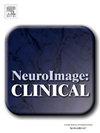Spectral peak analysis and intrinsic neural timescales as markers for the state of consciousness
IF 3.4
2区 医学
Q2 NEUROIMAGING
引用次数: 0
Abstract
Resting state EEG in patients with disorders of consciousness (DOC) is characterized by an increase of power in the delta frequency band and a concurrent decrease in the alpha range, equivalent to a weakening or disappearance of the alpha peak. Prolongation of Intrinsic Neural Timescales (INTs) is also associated with DOCs. Together, this raises the question whether the decreased alpha peak relates to the prolonged INTs and, importantly, how that can be used for diagnosing the state of consciousness in DOC individuals. Analyzing resting state EEG recordings from both healthy subjects and DOC patients, we measure INTs through autocorrelation window (ACW) and utilize peak analysis to quantify the weakening of the alpha peak. First, we replicate previous findings of prolonged ACW in DOC patients. We then identify significantly lower alpha peak measures in DOC compared to controls. Interestingly, spectral peaks shift from the alpha to the theta range in several DOC subjects while such change is absent in healthy controls. Next, our study reveals a close relationship between ACW and alpha peak in both healthy and DOC subjects, a correlation that holds for theta peaks in DOC. Further, the prolonged ACW correlates with the state of consciousness, as quantified by the Coma Recovery Scale-Revised (CRS-R), and mediates the relationship between theta peak and CRS-R. Finally, through split analyses and machine learning, we show that ACW and alpha peak measures conjointly distinguish healthy controls and DOC patients with high accuracy (95.5%). In conclusion, we demonstrate that the prolongation of ACW, together with spectral peak measures, holds promise to serve as additional EEG biomarkers for diagnosing the state of consciousness in DOC subjects.
作为意识状态标记的频谱峰值分析和内在神经时标
意识障碍(DOC)患者静息状态脑电图的特点是δ频段功率增加,同时α频段功率下降,相当于α峰值减弱或消失。内在神经时标(INTs)的延长也与 DOC 有关。这就提出了一个问题,即阿尔法峰的减弱是否与INTs的延长有关,更重要的是,如何将其用于诊断DOC患者的意识状态。我们分析了健康受试者和 DOC 患者的静息状态脑电图记录,通过自相关窗(ACW)测量 INT,并利用峰值分析来量化阿尔法峰的减弱。首先,我们复制了之前关于 DOC 患者 ACW 延长的研究结果。然后,我们发现 DOC 患者的阿尔法峰测量值明显低于对照组。有趣的是,在一些 DOC 受试者中,频谱峰值从 alpha 波段转移到了 theta 波段,而在健康对照组中却没有这种变化。接下来,我们的研究发现,在健康和 DOC 受试者中,ACW 与阿尔法峰之间存在密切关系,这种相关性在 DOC 的θ 峰中也同样存在。此外,延长的 ACW 与昏迷恢复量表-修订版(CRS-R)量化的意识状态相关,并介导了 Theta 峰值与 CRS-R 之间的关系。最后,通过分割分析和机器学习,我们发现 ACW 和阿尔法峰测量值可共同区分健康对照组和 DOC 患者,准确率高达 95.5%。总之,我们证明 ACW 的延长以及频谱峰值测量有望成为诊断 DOC 受试者意识状态的额外脑电图生物标志物。
本文章由计算机程序翻译,如有差异,请以英文原文为准。
求助全文
约1分钟内获得全文
求助全文
来源期刊

Neuroimage-Clinical
NEUROIMAGING-
CiteScore
7.50
自引率
4.80%
发文量
368
审稿时长
52 days
期刊介绍:
NeuroImage: Clinical, a journal of diseases, disorders and syndromes involving the Nervous System, provides a vehicle for communicating important advances in the study of abnormal structure-function relationships of the human nervous system based on imaging.
The focus of NeuroImage: Clinical is on defining changes to the brain associated with primary neurologic and psychiatric diseases and disorders of the nervous system as well as behavioral syndromes and developmental conditions. The main criterion for judging papers is the extent of scientific advancement in the understanding of the pathophysiologic mechanisms of diseases and disorders, in identification of functional models that link clinical signs and symptoms with brain function and in the creation of image based tools applicable to a broad range of clinical needs including diagnosis, monitoring and tracking of illness, predicting therapeutic response and development of new treatments. Papers dealing with structure and function in animal models will also be considered if they reveal mechanisms that can be readily translated to human conditions.
 求助内容:
求助内容: 应助结果提醒方式:
应助结果提醒方式:


